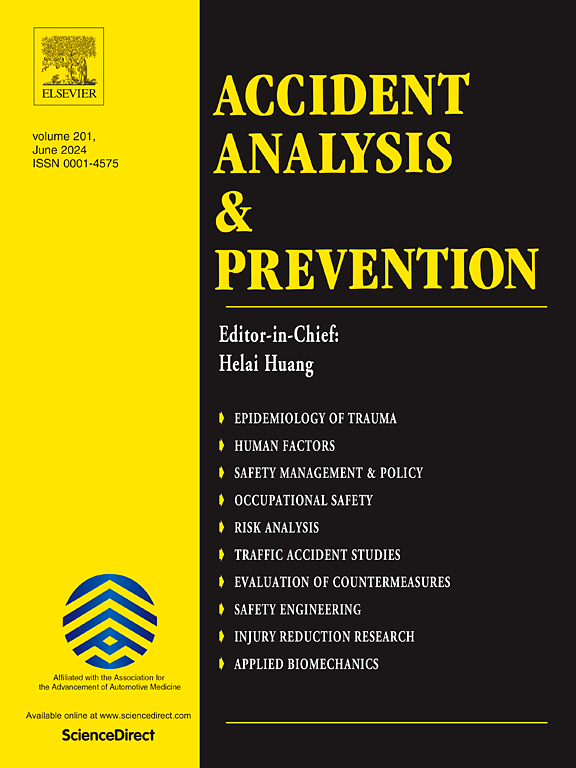探索有条件自动驾驶汽车中驾驶员的生理-心理状态对接管行为的影响
IF 5.7
1区 工程技术
Q1 ERGONOMICS
引用次数: 0
摘要
尽管自动驾驶有望提高驾驶安全性,但在紧急情况下,司机仍然需要接管车辆的控制权。驾驶员接管行为的估计是自适应驾驶自动化和接管请求(TOR)的基础,以确保驾驶安全。然而,尽管已经提出了通过生理和眼动追踪测量来估计驾驶员接管绩效的算法,但这些指标与驾驶员行为之间的复杂相互关系以及指标本身之间的相互作用尚未完全了解。为了回答这个问题,我们进行了一个42人参与的驾驶模拟实验。司机在驾驶有条件自动驾驶汽车时,经历了TOR要求的三种接管场景。收集驾驶员的生理、眼动追踪指标和心理状态,这些指标是由几个与驾驶无关的任务施加的。采用结构方程模型探讨生理指标(如心脏活动、呼吸活动、皮电活动)、眼动追踪指标、心理状态(如对驾驶自动化和感知工作量的信任)以及接管时间和接管质量变化之间的相互作用。结果表明,信任与接管质量呈正相关,而工作量与接管时间呈正相关。此外,生理和眼动追踪指标通过心理状态与接管质量间接相关。本研究揭示了接管绩效相关变量之间的层次关系,并为设计驾驶员监控系统提供了见解,旨在评估驾驶自动化和自适应驾驶自动化车辆的接管绩效,以提高驾驶安全性。本文章由计算机程序翻译,如有差异,请以英文原文为准。
Exploring how physio-psychological states affect drivers’ takeover performance in conditional automated vehicles
Although driving automation is promised to improve driving safety, drivers are still required to take over the control of the vehicles in case of emergency. Estimating drivers’ takeover performance serves as the basis for adaptive driving automation and takeover request (TOR) to ensure driving safety. However, although algorithms have been proposed to estimate drivers’ takeover performance through physiological and eye-tracking measures, the complex interrelationships between these metrics and driver behavior, as well as the interactions among the metrics themselves, are not fully understood. To answer this question, a driving simulation experiment involving 42 participants was conducted. Drivers experienced three types of takeover scenarios requested by TOR while driving a conditionally automated vehicle. Drivers’ physiological, eye-tracking metrics and psychological states, as imposed by several non-driving-related tasks were collected. A structural equation model was used to explore the interactions among physiological metrics (i.e., cardiac activity, respiratory activity, electrodermal activity), eye-tracking metrics, psychological states (i.e., trust in driving automation and perceived workload), and variations in takeover time and takeover quality. The results showed that trust was positively associated with takeover quality, while workload was positively associated with takeover time. Additionally, physiological and eye-tracking metrics were indirectly associated with takeover quality via psychological states. This study reveals the hierarchical relationship among takeover-performance-related variables and provides insights for designing driver monitoring systems aimed at estimating takeover performance in vehicles with driving automation and adaptive driving automation to improve driving safety.
求助全文
通过发布文献求助,成功后即可免费获取论文全文。
去求助
来源期刊

Accident; analysis and prevention
Multiple-
CiteScore
11.90
自引率
16.90%
发文量
264
审稿时长
48 days
期刊介绍:
Accident Analysis & Prevention provides wide coverage of the general areas relating to accidental injury and damage, including the pre-injury and immediate post-injury phases. Published papers deal with medical, legal, economic, educational, behavioral, theoretical or empirical aspects of transportation accidents, as well as with accidents at other sites. Selected topics within the scope of the Journal may include: studies of human, environmental and vehicular factors influencing the occurrence, type and severity of accidents and injury; the design, implementation and evaluation of countermeasures; biomechanics of impact and human tolerance limits to injury; modelling and statistical analysis of accident data; policy, planning and decision-making in safety.
 求助内容:
求助内容: 应助结果提醒方式:
应助结果提醒方式:


